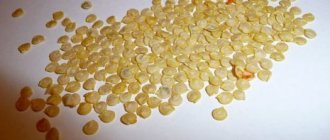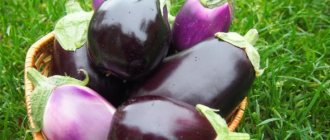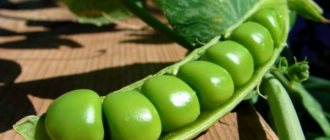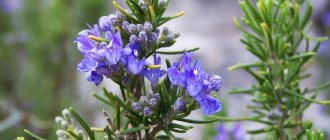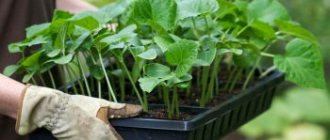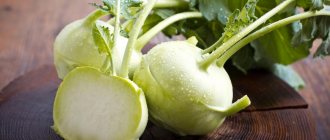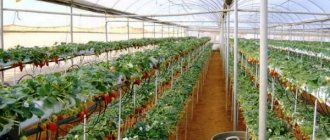Favorable conditions for growing berries in the Moscow region
Watermelons are heat-loving plants, so they need to be planted in open spaces with maximum sunlight. If the sprouts develop in the shade, then the crop may not have time to ripen before the onset of cold autumn.
Favorable conditions for growing watermelons in central Russia:
- the presence of light and fertilized soil, since the required amount of nutrients contributes to the development and rapid ripening of fruits;
- ensuring regular, but not too abundant watering, provided there is a complete absence of precipitation during the ripening period of the berries;
- when watering, water should fall into the root system, and not onto the leaves of watermelons;
- a good place for planting melons is an open area (a gentle slope without shade);
- seedlings should be planted in vertical rows, since in this order they grow well and are warmed by the sun;
- It is best to choose varieties with ripe fruits weighing no more than 4 kg, since they have time to ripen before autumn and are not inferior in sweetness and juiciness to their southern relatives.
The best varieties of watermelon for the Moscow region
Although watermelon is a crop that prefers warmth, thanks to breeders it can be successfully grown even in the Moscow region, for which varieties with a short growing season have been bred - early and mid-early. Therefore, it is worth dwelling on them in more detail.
For open ground
If there is no greenhouse structure on your site, then when choosing a watermelon you need to give preference to varieties that can be grown in unprotected soil conditions in your region. Since summer in the Moscow region is not distinguished by its duration and hot weather, it is recommended to cultivate the selected varieties in seedlings.
Suga Baby
The ripening period of this variety is 65–70 days. The fruits are characterized by a round shape, a thin skin of a dark green color. The pulp is sweet with a granular structure. The berry gains weight up to 6 kg. This variety is adapted to different climate conditions, so it can be used for cultivation not only in a greenhouse, but also in open ground.
Shuga Baby is an early ripening variety with a ripening period of 65–70 days and a berry weight of up to 6 kg
Maristo F1
This hybrid variety is characterized by early ripening within 58–60 days. A special feature is resistance to diseases such as anthracnose and fusarium. The fruits gain weight up to 11 kg, have a dark green peel color with light sides. The pulp of the berry is quite dense, sugary, has a rich color and a characteristic aroma. The harvest can be stored for a long time after harvesting.
A feature of the Maristo F1 variety is resistance to fusarium and anthracnose
Baraka F1
An early hybrid, ripening in 72–77 days when sown in open ground and 60–64 days after planting seedlings. The fruits are characterized by an oval shape and a weight of 11–13 kg. The pulp is dark red, sweet, and has no fibers. The variety is resistant to fusarium and anthracnose. Has a long shelf life.
The Baraka hybrid ripens in 72–77 days when sown in open ground and 60–64 days after planting seedlings
Ogonyok
An early ripening variety that ripens in 85 days and is suitable for conditions in the middle zone. The fruits gain weight up to 2.5 kg and have a thin dark green peel. The pulp is juicy, aroma, sweet, and has a bright red color. The variety is endowed with resistance to fusarium, but powdery mildew is possible.
Ogonyok is one of the popular early ripening varieties that is suitable for growing in the Moscow region
Erken F1
A new ultra-early hybrid with high yield, which achieves the best performance when grown through seedlings. Refers to unpretentious varieties that require minimal care. Fruiting is stable under different weather conditions. The fruits grow weighing 8–10 kg. The peel is light green in color with dark stripes. The pulp is dark red, crispy, sweet.
Erken F1 is an early variety that is endowed with high yield with fruits weighing 8–10 kg
Anniversary
Mid-season hybrid, ripening in 95 days. It can be cultivated in open ground and greenhouse conditions. The fruits are oval in shape and reach a weight of 10 kg. The color of the peel consists of dark green and light stripes. The pulp is sugary, juicy, tender, with a rich scarlet color.
Jubilee is a hybrid with a ripening period of 95 days, which can be grown in open ground and in a greenhouse
For the greenhouse
Growing watermelons in a greenhouse has its advantages, since it is easier for the plants to provide the necessary conditions.
Honey
The ripening of this early ripening variety begins 82–105 days after emergence. The fruits have an elongated round shape and reach a weight of 3–6 kg. The skin of the berries is medium thick, green with darker stripes. The red pulp has an excellent taste and is endowed with increased sugar content. The variety is moderately resistant to powdery mildew and other diseases of melons.
Watermelon of the Honey variety ripens 82–105 days after emergence, has elongated-round fruits weighing up to 6 kg
Skorik
An early ripening domestic variety that allows you to get a harvest within 65 days from the moment of germination. The fruits reach a weight of 3 kg, have a round-spherical shape, and a striped peel. The pulp of the berries is scarlet, juicy, dense, and has a rich aroma. Fruit ripening occurs almost simultaneously. You can store watermelon in the refrigerator for several months.
An early-ripening variety with large fruits up to 3 kg, which ripen 65–90 days after germination
Crimson suite
Mid-early variety, ripening in 70–85 days. The fruits are round in shape with a smooth skin, dark green in color with light stripes. The peel is smooth, dark green with light stripes. The average weight of berries is 8–12 kg. The flesh of the fruit has practically no veins, is scarlet, tender and honey-like in taste. Watermelon has a long shelf life.
A variety with early ripening, bright red and juicy pulp. Characterized by resistance to diseases and pests
Creamstar F1
A hybrid variety of super early ripening (56–60 days), which is suitable for open and closed ground. The fruits are characterized by a round shape, thin skin with dark stripes. The weight of the berries reaches 6–8 kg. The pulp is scarlet, juicy, tender, sweet. The variety is resistant to anthracnose and white rot, which makes it unpretentious to temperature changes.
Super early variety with a ripening period of 56–60 days. Watermelon is resistant to anthracnose and white rot
Choosing the right variety for planting
In order to grow watermelons in the Moscow region, you need to select early-ripening varieties of berries that ripen well in the following weather conditions:
- "Spark";
- "Producer";
- "Astrakhan";
- "Sugar Baby";
- "Coral";
- "Peasant";
- "Crimson Sweet";
- "Delicacy"
- "Siberian Lights";
- "Beijing Joy";
- "Gift to the North";
- "Arthur";
- "Hamlet";
- "Charles";
- "Albert."
The main advantage of the above varieties of watermelons is their speed of ripening, which is necessary for central Russia and the absence of a pronounced southern climate. Such fruits have time to ripen before the onset of the first cold weather and give a good harvest.
It is best to buy seeds in specialized stores. At the same time, preparing seeds at home can contribute to poor-quality growth of sprouts. Hybrids do not produce a good harvest again. Therefore, it is necessary to consult qualified specialists and purchase a quality product.
Currently reading: Secrets and technology of growing a square watermelon
Features of agricultural technology
Growing a good harvest of watermelons in a short, not hot summer is not an easy task. To achieve a good result, a number of growing conditions must be met.
Growing conditions:
- give preference for planting only early ripening varieties;
- cultivation should occur only by seedling method;
- use greenhouses or greenhouses for cultivating crops. For open ground conditions, use covering material;
- in the autumn period of preparation for winter, apply a large amount of organic fertilizers to the garden bed where watermelons are planned to be planted for the next year;
- for young plants, maintain the air temperature at least +12 degrees.
If you follow all the rules of agricultural technology and plant care, it will be very possible even for a beginner to get a good harvest.
Seed selection
The peculiarity of the culture is that it is not at all famous for its 100% germination of planting material. Therefore, you need to purchase 3 times more seeds than planned for planting. In addition, gardeners have the peculiarity of trying to plant several varieties and hybrids at once in one season, which is not at all prohibited. You need to sow 4-6 more seeds than the number of holes prepared for planting.
Germination
Watermelon seeds must be germinated before sowing. Firstly, this is necessary in order to find out the amount of planting material that can germinate. Secondly, seed germination promotes faster germination.
For germination, planting material must be placed in a dry, warm place. In a week they should hatch. If this does not happen on time, it will not be too late to repeat the procedure and germinate more. In order to germinate watermelon seeds faster, you must follow certain rules.
Often, planting material from manufacturers is sold in the form of granules; such seeds do not need to be soaked; they undergo special treatment, thanks to which the seeds are saturated with nutrients and essential microelements. Preparing seeds for germination is not an easy and time-consuming task. To properly prepare them, you need to familiarize yourself with the rules of germination.
May be interesting Phalaenopsis Orchid - subtleties of care at home after the store When to plant zucchini seedlings in 2019? When to plant a plum in the fall so that it takes root?
Germination rules:
- the seeds are not in granules, you need to immerse them in water for a few seconds, then drain the water and rinse well;
- Place each variety of planting material in a separate canvas bag, tie it and immerse in hot water at a temperature of 50-60 degrees for 30 minutes;
- after hot water, the bags should be placed in cold, settled water without chlorine;
- Separately in a glass container, dilute 15 drops of the drug Phytosphorin - M in 1 tbsp. water and immerse the bags in it for 8-10 hours;
- after that, place the bags in a plastic bag and put the seeds in the refrigerator for 12 hours;
- then wrap the bags individually in cloth and put them in a bag. Place all bags with planting material in a warm place for 2 days, at a temperature of +24+28 degrees. This place could be the top shelf of a kitchen cabinet. In this case, the bags need to be unfolded every day for ventilation, 2 times a day.
It is necessary to plant the planting material on the 3rd day after the procedure; it is not recommended to delay planting longer, since the fragile roots can be broken off later.
Transplantation into containers
Growing watermelons in the Moscow region in open ground, it is recommended to cultivate them using the seedling method. Planting material should be planted in early May until mid-May. The seedlings will take root well and will grow actively if they are about a month old during the period of planting in the ground. Therefore, you need to roughly calculate at what time it would be best to plant the seeds.
It is recommended to plant seeds in plastic pots with an optimal capacity of 0.5 liters. Watermelons do not require drainage, but holes in the bottom are necessary. Each cup should have 3-4 holes, 1 cm in diameter.
Before planting, it is necessary to prepare a soil mixture, which consists of several components.
Soil mixture:
- peat;
- turf soil;
- humus.
All components of the soil mixture must be taken in equal parts and mixed well. Fill the pots with the mixture and plant 1-2 seeds in one container, to a depth of 2-3 cm. During this period, the plants need moderate regular watering. The process should take place in the evening.
Containers for watermelon seedlings need to be filled halfway with soil and the soil lightly compacted. Then lay out the seeds and sprinkle with soil, 2 cm thick, and tamp down a little again. Sprinkle generously of coarse sand on top, which must be rinsed and calcined well in advance. Before the first shoots appear, the containers are placed in a warm place; there is no need to water at all.
You can also plant seeds in a similar way in large containers. In this case, they require picking into separate containers during the period when 2 true leaves appear. After 10 days, a mandatory preventive measure is to lower the night temperature. Now it should be 18-20 degrees. This must be done to prevent the sprouts from stretching out.
Seedling care
How to grow watermelon in the Moscow region in open ground, and when to plant seedlings, is not an easy task, but an interesting one. The most important thing is to provide proper care for the seedlings; this will be half the guarantee of a good harvest.
After the first shoots appear, it is necessary to provide the crop with 12 hours of daylight. After 2 leaves appear, the seedlings should be fed with liquid organic fertilizers. You can use store-bought fertilizers for seedlings or indoor flowers. 2 tbsp. l. There will be enough for each plant, then immediately water it with water.
It is necessary to fertilize seedlings with extreme caution. Fertilizer is applied at the very root of the plant. Under no circumstances should you touch the leaves. After 1 day, the seedlings should be placed on a windowsill or in a lighted place. The most important thing is that the seedlings are not exposed to drafts at this time.
The second time, after 10-12 days, it is necessary to feed the seedlings with a solution of wood ash. The solution is infused as follows: 2 tbsp. l. Dissolve wood ash in 1 liter of boiling water, close with a lid and seal tightly. Leave the solution for a day, strain, after which you can use it.
If the seedlings are exposed to direct rays of the sun, they may lie down on the soil, but do not be alarmed; after some time, they will rise again.
Planting watermelon seedlings in the soil
Watermelon loves space and light. Therefore, he needs to allocate a spacious area where the sun will illuminate him all day long. He does not tolerate darkness. A site with a slight slope is perfect. But, in this case, it should be planted not from top to bottom, but in a horizontal direction.
The crops are planted in the beds. They should be prepared in the fall. The fertile loose layer should be at least 40 cm deep; it is to this depth that watermelon roots grow. If this condition is not met, the culture will not be able to develop properly and will slow down in growth.
Before planting, you should prepare the holes. They should be at least 40-45 cm deep. After preparing the holes, they need to be fertilized. To do this, you need to add 2 shovels of well-decomposed humus and 3 liters of sand into each. If the soil is heavy and clayey, you need to add a little more humus and sand.
In regions with cold climates, it is recommended to plant watermelons in high, warm beds. They can be prepared as follows: biofuel must be placed in a deep trench. Dig holes on both sides of the trench, and the distance between the beds should be at least 3 m, between the rows and plants - 1 m. With this planting method, the plant will have space, it will grow and develop properly.
Before planting, you need to check the soil temperature. This can be done with a simple thermometer. The optimal option for landing is +15 degrees. After planting, it is advisable to cover the crop with covering material or cut 5 liter plastic bottles for each plant.
Important!
It is recommended to use spunbond as a covering material; it is strictly forbidden to cover watermelons with plastic film. Otherwise, plant death can be expected.
How can you plant watermelons in the same bed?
It is strictly forbidden to plant watermelons and melons next to each other if you plan to get seeds from them. If there are no such plans, they can perfectly coexist and cross-pollinate.
It is not advisable to plant a watermelon in a neighboring bed next to pumpkin, zucchini and cucumbers. Also, they cannot grow near trees and bushes.
In the next bed with watermelon, you can plant:
- radish;
- corn;
- spinach;
- any greens except parsley.
Watermelons feel comfortable in the place where their predecessors grew last season.
Preparing and planting seeds
The process of growing watermelons begins with planting seeds into seedlings (late April). Within 14 days, the sprouts grow and become ripe for transplanting into open ground. At the same time, the prepared material purchased in the store does not require additional soaking.
Seeds prepared at home require additional care:
- choosing dense, large seeds without visible damage (they are immersed in a glass of water for 10–15 minutes);
- seeds for planting are heated in the oven at a temperature of no more than 50 degrees for 1 hour to harden and form more female inflorescences;
- the treated seeds are thoroughly washed in a solution of potassium permanganate as a disinfectant and rinsed with clean water;
- Ready seeds are planted in pre-prepared soil.
Planting seeds:
- peat cups or other containers are half filled with special soil (earth mixed with sand in equal proportions);
- make a small depression in the soil, water it with water and plant the seed at a distance from the surface of no more than 3 cm);
- seedlings should receive the maximum amount of sunlight;
- daytime temperature is 23–25 degrees, night temperatures should not be below 20 degrees.
Watering seedlings is best done in the evening directly into the ground without using the emerged leaves.
Growing instructions
Watermelon is a southern crop that loves sunshine and warmth. Therefore, seedlings are planted in open ground only after the soil has warmed up well. The soil temperature must be at least +15°C.
When using the seedling method, the seeds are sown in late April-early May. Plants are planted in the garden a month after sowing.
Preparatory stage
This stage consists of preparing the soil and seed material.
For watermelons, choose an open sunny area. Unfavorable predecessors for melons are legumes and cabbage. Desirables: potatoes, onions, tomatoes.
Important! Watermelons do not grow well in acidic soil.
In the fall, the garden bed is dug up, cleared of weeds, and fertilizers, compost, and humus are added. If the soil is acidic, add slaked lime, dolomite, wood ash and ground chalk.
Seed preparation
Preparing seeds for planting speeds up the emergence of seedlings. The seeds are wrapped in paper or cloth and kept in warm water until they bite.
Treating seeds helps protect young plants from diseases. To do this, they are kept for half an hour in a solution of potassium permanganate, and then washed with clean water.
Growing seedlings
Sprouted seeds are planted in separate containers filled with soil to 2/3 of the volume. Then the elongated sprouts can be sprinkled with soil, and they will give additional roots.
Advice. Choose individual glasses for seedlings with a volume of at least 0.3-0.5 liters.
Watermelons do not like transplanting. Peat or plastic cups with a diameter of at least 15 cm are ideal for plants.
The seeds are placed in glasses and buried 2 cm. The top layer of soil is slightly compacted. The land is well watered. After this, the glasses are transferred to a warm, sunny place.
Plants are transplanted to a permanent location when they grow 2-3 leaves. A few days before planting, the seedlings are hardened off by gradually lowering the air temperature.
Planting in open ground
Watermelons are transplanted into the garden in early June, when the threat of cold weather has passed. When using shelters, seedlings are planted earlier, starting 3 weeks after sowing the seeds.
The seedlings are transplanted into prepared holes, after thoroughly moistening the bottom of the hole. The distance between holes is determined based on the recommendations of the seed manufacturer. The earth ball is not buried; it should rise 1-2 cm above the soil surface.
Attention. Deepening the earthen ball when planting seedlings leads to rotting of the root collar.
Care
The planted seedlings are protected from temperature changes and cold winds with film. The shelter is constantly ventilated to avoid the formation of condensation. The protective shelter is removed with the arrival of real warmth.
Watering
The watermelon bed is watered about once a week. When watering, avoid getting moisture on the foliage and vines. Using a layer of mulch reduces the amount of watering and loosening. In addition, mulch increases the temperature of the soil at the surface.
During the flowering period, plants are watered less frequently, approximately once every two weeks. Watering is stopped during fruit filling and ripening.
Feeding
Approximately 20 days after planting the seedlings, fertilizing is applied. As a fertilizer, use a solution of ammonium nitrate (at the rate of 20 g per 1 bush), or complex fertilizers in accordance with the manufacturer’s recommendations. During the budding period, fertilizers are applied again.
Topping
Pinching watermelon vines is an important agricultural technique that allows you to speed up the ripening of fruits in the short summer near Moscow.
Pinching begins with the removal of side shoots. From 4 to 6 fruits are left on the main lash, after which it is also pinched.
The vine is cut off, leaving 4-5 leaves after the last fruit. These leaves help the bush receive adequate nutrition.
As they grow, new vines grow on the bushes. They are also pruned, periodically inspecting all the bushes.
Planting seedlings in open ground
Planting watermelon seedlings in the Moscow region must be done at an average daily temperature of at least 15 degrees (this period occurs at the end of May or the beginning of June). At the same time, the sprouts have a well-developed root system and fully formed 4 or 5 leaves.
The soil for planting must be prepared in the autumn:
- dig up the ground well and remove all weeds;
- if the soil is clayey. Then you need to add sand to create the most favorable soil;
- application of organic fertilizers (cow, bird droppings). Nutrients are well absorbed in the soil and prepare the soil for further growing of watermelons.
Currently reading: How to choose a delicious watermelon: main features
When March comes, the soil for planting is heated with ash, and in mid-April it is watered with warm water and covered with film on top. The favorable time for planting seedlings is the end of May or the beginning of June.
Small depressions are made in the prepared soil and the seedlings are planted at a distance of 150 cm from each other so that the watermelons grow well and produce the required amount of harvest. To ensure the safety of sprouts, it is best to try to create greenhouse conditions that can be removed with stable warming in the region.
Possible problems and solutions
When growing watermelons in the Moscow region, gardeners are faced with melon diseases and pest damage to the plantings.
Diseases
Watermelon bushes are affected by diseases such as anthracnose, fusarium, and powdery mildew.
Anthracnose is a fungal disease that affects leaves, stems and the fruits themselves. The fungus is dangerous because it leads to the complete death of the bush. The development of the disease is provoked by excessive moisture in the soil and air.
Fusarium is a fungal disease that affects leaves and canes. The disease causes greenery and stems to wilt. The fungus enters the plant through the root system. Gradually the stems become thinner and darker. The risk of infection increases with excessive watering.
Powdery mildew is another fungal disease. The disease is recognized by white spots on the leaves. Plants affected by the fungus shrink and dry out, and the formed fruits stop growing and filling.
If a fungal disease is detected, the affected parts of the bush are removed and burned. The remaining plants are sprayed with fungicides. The solution is prepared in accordance with the recommendations of the drug manufacturer. Spraying is stopped three weeks before harvest.
Pests
Melon aphids, wireworms, meadow moths, and cutworms are dangerous for watermelon beds. If insects are detected, the bushes are treated with biological products or chemical insecticides.
Traditional methods of control include spraying bushes with an infusion of ash, onion peels, and garlic. The bushes most affected by parasites are removed and burned.
Preventive measures
The occurrence and development of diseases will be prevented by compliance with growing conditions and the selection of varieties resistant to diseases.
Important! Thickening of plantings is one of the main reasons why watermelons are affected by fungal diseases.
Preventive measures include treating seeds and soil with biofungicides before planting, maintaining the required distances between plants when planting seedlings, clearing the area of plant debris in the fall, and timely application of fertilizers.
Caring for planted watermelons on the ground
Caring for planted plants requires following certain recommendations:
- eliminating weeds in the area where watermelons grow;
- regular watering and application of mineral fertilizers, preferably in the evening, provided there is no natural rain on the soil;
- The first feeding of watermelons is carried out 10 days after planting (ammonium nitrate solution in a proportion of 4 grams per 2 liters of warm water, cow droppings or herbal decoction with the addition of ash);
- carrying out artificial pollination (transferring male pollen to female inflorescences using a soft or fluffy brush);
- During the flowering period, secondary shoots on the ground are removed to obtain the maximum number of ripe fruits.
Obtaining watermelon seedlings
In nature, watermelon spreads its seeds with the help of animals. The desert fox or lizard eats the pulp to replenish its body's moisture reserves and runs on. The pulp is digested very quickly, but the seeds do not have time, only damaging their shell. The animal drops undigested seeds at some distance from the bush, and this is what the watermelon needs. He is so accustomed to such treatment that his seeds germinate much better after heating and scarification.
Seeds of watermelon
To increase germination, the melon grower will have to imitate the passage of seeds through the stomach of an animal. To do this, the seeds are placed in a thermos, in water heated to about 40 degrees, and kept for 2-3 hours. Then wrap it in damp gauze and place it in a plastic bag near a heat source, such as a heating radiator.
To prevent the seeds from suffocating, the bag is opened slightly for ventilation several times a day.
Watermelon sprouts
In about a week, seedlings will appear. Considering that watermelon, like all pumpkin plants, reacts very painfully to transplants, there are no plans to pick seedlings. Therefore, the seedlings are immediately planted in a container in which they can later be planted in the soil of the greenhouse: peat pots or peat tablets. Planting depth is 3-4 cm.
Attention! For watering watermelons, like cucumbers, only warm water is suitable.
Advice and recommendations from experts
List of useful tips from experienced gardeners:
- It is best to use seedlings for planting;
- in greenhouses, watermelons should be grown on trellises;
- to prevent fruit disease, it is necessary to lay wood or a layer of dry straw;
- Experts recommend trying planting several varieties and finding the optimal option that is ideal for the prevailing weather conditions.
Currently reading: How to properly grow a watermelon in the country
How to care for watermelons?
We recommend reading our other articles
- Peach variety Golden Jubilee
- The best varieties of blackcurrant
- Durum wheat varieties
- Spathiphyllum flower (Women's happiness)
From the moment of pinching, the plant requires special care.
- There should be as much sun as possible.
- To prevent the plant from drying out, water it generously 2 times a week with warm water.
- To prevent the stems and, mainly, the fruit from rotting, it is worth laying cardboard or wooden planks between them and the ground.
- From time to time, the crop is loosened, all weeds are pulled out and complex fertilizer is applied.
Planting and caring for melons in the Moscow region
The best varieties of melon for the Moscow region: Kolkhoznitsa, Gribovskaya ground, Kazachka 244, Zolotistaya, Yantarnaya. For seedlings, select the heaviest and largest seeds, which are pickled in a solution of potassium permanganate and germinated in moistened tissue.
Growing melon seedlings
In a 0.5 liter pot, coarse sand with scalded and dried sawdust 1:1 is placed at the bottom as drainage. Soil steamed from the fungus with peat is placed on top. The ground is pre-fertilized using 0.5 cups of wood ash, 1 tbsp. l. superphosphate and 0.5 tbsp. l. potassium phosphate per 3 l. Water with a warm solution of manganese.
Processed melon seeds for growing in the Moscow region
The seeds are laid horizontally, sprinkled with 2 cm of soil on top, and compacted. Seedlings are watered moderately to avoid root rot, fertilized with mullein (1:10 with water) and complex mineral fertilizers immediately before planting.
Transplanting melon into a greenhouse
Month-old sprouts are planted in a greenhouse in one row at a distance of half a meter from each other in the first ten days of June. Melon is grown in a greenhouse in two ways: on trellises in a suspended state or on the ground spread out.
Growing melon on trellises in the Moscow region
After planting, the plant must be pinched above the 4th leaf, regardless of the planting method. During the formation of lashes, the weak ones are removed by sprinkling the wound with crushed coal.
Pollination and feeding
With the appearance of flowers, the first inflorescences are pollinated by hand, to further attract bees by spraying the plants with water and honey in equal proportions. For better fruit formation, up to 5 inflorescences are left on the stem, the temperature under cover is constantly maintained at plus 30 degrees Celsius, and watered with warm water twice a week.
Formation of melon fruits
During the season, melon is fed three times:
- 4 days after planting, the seedlings are fertilized with a solution of mullein or bird droppings (1:10) with the addition of 1 tbsp. l. superphosphate per 10 liter bucket of water;
- For the second feeding during the formation of lashes, use wood ash (1 cup per 10 liters of water);
- During the formation of ovaries, complex fertilizing is applied at the rate of 1 tbsp. l. for 10 liters of water.
With a dry and sunny summer, the first melons will ripen in the first ten days of September.
Disease and pest control
During the growing season, the crop can be affected by fungal diseases and attacked by pests.
Watermelon diseases
Anthracnose - affecting the stem, leaves and berries, leads to the death of the bushes. Brown spots appear on the pumpkins, and the stems become covered with ulcers. The appearance of fungus is caused by waterlogging of the soil and high air humidity.
Fusarium - the disease begins due to putrefactive processes in the root system. The vines darken and become thinner, the leaves fade, and the fruits become smaller. Fusarium is caused by improper watering.
Root rot is caused by fungi that live in the soil. With temperature fluctuations and excessive watering, they are activated. The root thickens and becomes covered with cracks, the leaves turn yellow, and the bush gradually dies.
Powdery mildew is a striking symptom - wrinkled, dry leaves covered with white spots. The bush stops growing, the fruits stop developing. The disease is caused by low temperatures and prolonged rains; excessive watering.
Landing dates
Usually, watermelons in the Moscow region are planted in the ground in the first ten days of June, when stable warm weather sets in. By the time of planting, at least two true leaves grow on the bush.
Soil preparation
A suitable place for the culture is well lit and reliably protected from the gusts of the prevailing wind. A site on which legumes and onions grew is suitable. Poor predecessors include vegetables from the Pumpkin family. A week before planting, make a warm bed based on a trench. The bottom is covered with cut grass, humus and watered with boiling water. The top is covered with earth and covered with film.
The seedlings are planted in holes that have been previously watered with a saturated solution of potassium permanganate. When planting, they try not to touch the roots: watermelon does not tolerate changing places. Plastic cups are carefully removed, peat cups are left unchanged. They are planted without deepening the soil, otherwise the root collar may rot.
Planting scheme
For the development of the plant, a lot of space is needed so that the lashes lie freely. When planting bushes, maintain a distance of 0.8 m between them in a row, and a distance between rows of at least 200 cm.
Sowing seeds for seedlings
The second ten days of May, it is better to place 2-3 seeds in peat pots (then weak shoots are plucked out at the stage of two cotyledon leaves). For seedlings to emerge, the soil temperature must be at least 20-25 °C. Soil mixture: turf soil, sand, peat, humus (2:1:2:2), 1 tbsp. l. complex fertilizer.
The emergence of seedlings occurs in 5-6 days. Planting in the ground - 3 weeks after germination (the second ten days of June, since the threat of frost in the Moscow region passes after June 5-10). When planting, carefully remove the walls of the peat pot to make it easier for the root system to break through to the ground. First, water the holes generously, in several stages, and add 1 tbsp. l. complex fertilizer per hole. After planting the plant, sprinkle it with soil up to the root collar and do not water it again so that the soil is loose. Temporarily (for about 2 weeks) we cover the planting with non-woven material (this way the plants take root better and the birds do not touch them).
The distance between plants is 1.5×1.5 m.
